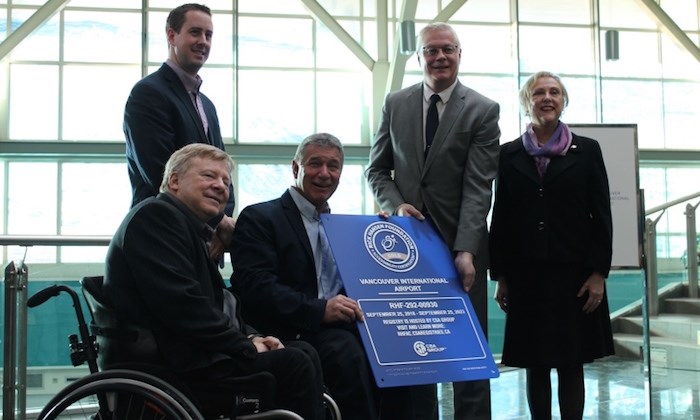Preparing for travel, navigating the airport, going through security and flying can all be stressful experiences. Add in mobility, vision or hearing impairments and that stress could be magnified significantly.
Vancouver International Airport has taken several measures to ensure the airport can be navigated by all of its employees, passengers and partners. And, on Wednesday, YVR was recognized for its efforts with the Rick Hansen Foundation’s “accessibility certified gold” rating.
 Richmond’s Rick Hansen and (centre) presents YVR’s Craig Richmond with a plaque recognizing its “accessibility certified gold” rating. Photo: Alyse Kotyk
Richmond’s Rick Hansen and (centre) presents YVR’s Craig Richmond with a plaque recognizing its “accessibility certified gold” rating. Photo: Alyse Kotyk
This recognition made YVR the first airport to receive the rating and marked YVR as the highest rated building in the foundation’s certification program.
Richmond’s own Rick Hansen was at the airport on Wednesday to talk about YVR’s accessibility initiatives.
“Accessibility has been the original dream of my ‘Man in Motion’ world tour, to create a world that’s accessible and inclusive for all people with disabilities,” Hansen said.
“YVR has been a friend and a partner and ultimately has been part of the journey themselves in trying to identify and remove barriers on the long journey of social change.”
As the highest rated building under the Rick Hansen Foundation’s certification program, YVR has a score of 93 out of 100 points.
Jeffrey Feldman, scheduling coordinator with the Rick Hansen Foundation Accessibility Certification program, has visual and mobility impairments, and explained that the airport’s textured flooring helps him navigate easily.
“The different flooring in the airport really does stand out for someone with a visual issue,” Feldman said.
Throughout the airport, floor textures are used to indicate a different area. Tile or terrazzo indicates there’s an exit nearby, carpet indicates a nearby gate and laminate flooring indicates a retail area.
Feldman added that the airport’s signage is also helpful.
“The key signage…is backlit,” he explained. “For someone with a visual issue, that type of signage is really much easier for someone to see versus something that’s really bright and shiny.”
For Marco Chiaramonte, who is a team leader at the Western Institute for the Deaf and Hard of Hearing and is hard of hearing himself, the biggest challenge at the airport is being able to hear public announcements.
“There are some adaptive speakers throughout this airport. That really benefits me to hear any important announcements,” Chiaramonte explained, adding that visual paging systems on screens are also helpful.
YVR has a host of other accessibility features including universal food and service counters for people using wheeled mobility devices, low-resistance carpeting, curbside ramps, accessible parking and washroom stalls wide enough to accommodate mobility devices.
However, for Brad McCannell, who is vice president of access and inclusion at the Rick Hansen Foundation, creating a truly accessible space is more than just the individual structures in a building.
 Brad McCannell, vice president of access and inclusion at the Rick Hansen Foundation, explains that service counter and information screen heights all help the airport be more accessible. Photo: Alyse Kotyk
Brad McCannell, vice president of access and inclusion at the Rick Hansen Foundation, explains that service counter and information screen heights all help the airport be more accessible. Photo: Alyse Kotyk
“It’s not just about counter heights and slopes. That’s the outcome. What…we’ve been able to do (at the airport) is change design culture,” he said.
McCannell explained that the airport conducts regular exit surveys and one year, the focus was to gather feedback from people with disabilities. Some who replied said their experience was “great,” but couldn’t pinpoint the reasons why.
“That’s the perfect answer,” McCannell said. “Because if you don’t know, I didn’t segregate you. I didn’t handle you any differently or throw you in a back door. You just walked along with everybody else.”



